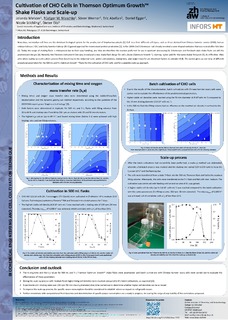Please use this identifier to cite or link to this item:
https://doi.org/10.21256/zhaw-1151Full metadata record
| DC Field | Value | Language |
|---|---|---|
| dc.contributor.author | Meister, Jolanda | - |
| dc.contributor.author | Maschke, Rüdiger | - |
| dc.contributor.author | Werner, Sören | - |
| dc.contributor.author | Abellan, Eric | - |
| dc.contributor.author | Stichling, Nicole | - |
| dc.contributor.author | Egger, Daniel | - |
| dc.contributor.author | Eibl, Dieter | - |
| dc.date.accessioned | 2016-09-01T12:43:11Z | - |
| dc.date.available | 2016-09-01T12:43:11Z | - |
| dc.date.issued | 2016-09-05 | - |
| dc.identifier.uri | https://digitalcollection.zhaw.ch/handle/11475/1142 | - |
| dc.description.abstract | In biotechnology, the usage of shaking flasks in upstream processing is widely common due to the easy handling. Frequent applications are process screening and optimization. Thereby, the focus lies mostly on a homogeneous and fast distribution of substrates and gases whilst power consumption and shearing force are meant to be kept low, which ideally results in high biomass concentrations and product titers. For characterization purposes, the mixing time and the oxygen mass transfer coefficient (kLa) were measured in 5 L and 500 mL Thomson Optimal Growth™ shaking flasks, using the de-colorization or the dynamic gassing-out method, respectively. Those geometrical optimized bioreactors are promising higher space-time yields compared to the predominant Erlenmeyer-shake flask design. According to the results of the procedural experiments, CHO (Chinese hamster ovary) cells were cultivated at selected, auspicious parameter combinations. The effectiveness of the predetermined parameters was evaluated and a scale-up method elaborated. The results can be summarized as follows: The key parameter for all experimental setups is the shaking rate. In contrast, the filling volume showed to have a more ambiguous role. Modeling results in the 500 mL flasks showed no significant influence of the filling volume to the maximal cell density, in contrast to the 5L flask (both shaken at 50 mm throw). The highest viable cell density (up to 4.8∙10⁶ cells mL⁻¹) was reached using the 500 mL flask with high shaking rates at 50 mm shaking diameter. Thereby, a µmax of 0.038 h-1 was achieved that correlates with a td of less than 19 h. All in all, the highest µmax of 0.055 h⁻¹ was reached during the scale-up process, whereby higher viable cell densities were reached compared to the batch cultivations using the same parameter settings. In addition to the experiments performed to date, simulations with computational fluid dynamics and experimental determination of specific power consumption rates are already in progress, increasing the range of applicability and the validity of the proposed model correlations. | de_CH |
| dc.language.iso | en | de_CH |
| dc.publisher | ZHAW Zürcher Hochschule für Angewandte Wissenschaften | de_CH |
| dc.rights | Not specified | de_CH |
| dc.subject | Mixing time | de_CH |
| dc.subject | Oxygen mass transfer | de_CH |
| dc.subject | CHO cells | de_CH |
| dc.subject | Thomson Optimum Growth | de_CH |
| dc.subject | Scale-up | de_CH |
| dc.subject.ddc | 660.6: Biotechnologie | de_CH |
| dc.title | Cultivation of CHO Cells in Thomson Optimum Growth™ Shake Flasks and Scale-up | de_CH |
| dc.type | Konferenz: Poster | de_CH |
| dcterms.type | Text | de_CH |
| zhaw.departement | Life Sciences und Facility Management | de_CH |
| zhaw.organisationalunit | Institut für Chemie und Biotechnologie (ICBT) | de_CH |
| zhaw.publisher.place | Wädenswil | de_CH |
| dc.identifier.doi | 10.21256/zhaw-1151 | - |
| zhaw.conference.details | Biotech 2016: Biopharmaceutical Manufacturing and Single-Use Technologies | de_CH |
| zhaw.funding.eu | No | de_CH |
| zhaw.originated.zhaw | Yes | de_CH |
| zhaw.publication.status | publishedVersion | de_CH |
| zhaw.publication.review | Peer review (Abstract) | de_CH |
| Appears in collections: | Publikationen Life Sciences und Facility Management | |
Files in This Item:
| File | Description | Size | Format | |
|---|---|---|---|---|
| Meister-biotech2016.pdf | 867.72 kB | Adobe PDF |  View/Open |
Show simple item record
Meister, J., Maschke, R., Werner, S., Abellan, E., Stichling, N., Egger, D., & Eibl, D. (2016, September 5). Cultivation of CHO Cells in Thomson Optimum Growth™ Shake Flasks and Scale-up. Biotech 2016: Biopharmaceutical Manufacturing and Single-Use Technologies. https://doi.org/10.21256/zhaw-1151
Meister, J. et al. (2016) ‘Cultivation of CHO Cells in Thomson Optimum Growth™ Shake Flasks and Scale-up’, in Biotech 2016: Biopharmaceutical Manufacturing and Single-Use Technologies. Wädenswil: ZHAW Zürcher Hochschule für Angewandte Wissenschaften. Available at: https://doi.org/10.21256/zhaw-1151.
J. Meister et al., “Cultivation of CHO Cells in Thomson Optimum Growth™ Shake Flasks and Scale-up,” in Biotech 2016: Biopharmaceutical Manufacturing and Single-Use Technologies, Sep. 2016. doi: 10.21256/zhaw-1151.
MEISTER, Jolanda, Rüdiger MASCHKE, Sören WERNER, Eric ABELLAN, Nicole STICHLING, Daniel EGGER und Dieter EIBL, 2016. Cultivation of CHO Cells in Thomson Optimum Growth™ Shake Flasks and Scale-up. In: Biotech 2016: Biopharmaceutical Manufacturing and Single-Use Technologies. Conference poster. Wädenswil: ZHAW Zürcher Hochschule für Angewandte Wissenschaften. 5 September 2016
Meister, Jolanda, Rüdiger Maschke, Sören Werner, Eric Abellan, Nicole Stichling, Daniel Egger, and Dieter Eibl. 2016. “Cultivation of CHO Cells in Thomson Optimum Growth™ Shake Flasks and Scale-Up.” Conference poster. In Biotech 2016: Biopharmaceutical Manufacturing and Single-Use Technologies. Wädenswil: ZHAW Zürcher Hochschule für Angewandte Wissenschaften. https://doi.org/10.21256/zhaw-1151.
Meister, Jolanda, et al. “Cultivation of CHO Cells in Thomson Optimum Growth™ Shake Flasks and Scale-Up.” Biotech 2016: Biopharmaceutical Manufacturing and Single-Use Technologies, ZHAW Zürcher Hochschule für Angewandte Wissenschaften, 2016, https://doi.org/10.21256/zhaw-1151.
Items in DSpace are protected by copyright, with all rights reserved, unless otherwise indicated.